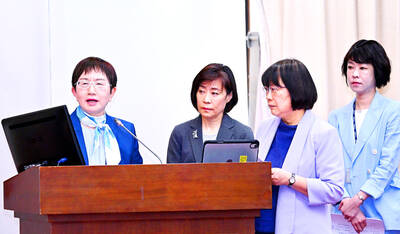Taiwan Semiconductor Manufacturing Co (TSMC, 台積電), the world’s top contract chipmaker, yesterday said it planned to start mass-producing next-generation 450mm wafers using advanced 10-nanometer technology in 2018.
The plan was included in the latest technology roadmap unveiled by TSMC about one year after the chipmaker attributed its delay in making 450mm wafers, originally scheduled in 2015, to semiconductor equipment suppliers’ postponement in developing advanced equipment for manufacturing amid the industrial slump.
The 450mm wafers would help solve the problem of rising costs in making advanced chips, allowing TSMC to provide affordable 10 nanometer chips with FinFET transistors for customers, J.K. Wang (王建光), vice president of TSMC’s operation in charge of 300mm factories, told a media briefing arranged by semiconductor industry association SEMI.
Cost constraints rather than technological constraints for chipmakers to migrate to next-generation chips via shrinking chip geometry, he said.
Chipmakers can get 2.5 times more chips from a 450mm wafer than from a 300mm wafer.
The advanced 10-nanometer chips could first be used in mobile devices and other consumer electronics, like game consoles, that demand high-performance and low power consumption, Wang said.
TSMC planned to build a pilot production line to make 450mm wafers between 2016 and 2017, when semiconductor ASML Holding NV had its key equipment ready in 2015, Wang said.
The chipmaker would consider building major 450mm-wafer production lines in Greater Taichung, he said.
Early this year, TSMC joined the Global 450 Consortium in a move to facilitate the transition of 450mm wafer production from its current 300mm wafers in collaboration with the world’s major chip companies, Intel Corp, Samsung Electronics Co, IBM Corp and GlobalFoundries Inc, Wang said.
Each company sent 20 engineers to jointly develop the technology and overcome challenges, Wang said.
Taiwanese chipmakers are expected to spend 8 percent more on semiconductor equipment to U$9.2 billion this year from last year’s US$8.2 billion, primarily driven by contract chipmakers, TSMC in particular, SEMI analyst Clark Tseng (曾瑞榆) said.
That was a contrast to an annual decline of 2.6 percent in spending by global chip companies this year, SEMI said.
TSMC planned to spend US$8.5 billion on new equipment this year.
Next year, Tseng expects local chipmakers to budget more than US$9 billion in total on new semiconductor equipment, meaning little change from this year’s spending. Any improvement in the macroeconomy would allow an upward revision, he said.
Taiwan and South Korea are expected to be the two largest markets for semiconductor equipment this year, with purchases totaling US$9.26 billion and US$11.48 billion respectively, according to SEMI figures.
TSMC shares rose 0.12 percent to NT$84 yesterday, outperforming the TAIEX’s 0.01 percent gain, while rival United Microelectronics Co (聯電) was flat at NT$11.95.

‘SWASTICAR’: Tesla CEO Elon Musk’s close association with Donald Trump has prompted opponents to brand him a ‘Nazi’ and resulted in a dramatic drop in sales Demonstrators descended on Tesla Inc dealerships across the US, and in Europe and Canada on Saturday to protest company chief Elon Musk, who has amassed extraordinary power as a top adviser to US President Donald Trump. Waving signs with messages such as “Musk is stealing our money” and “Reclaim our country,” the protests largely took place peacefully following fiery episodes of vandalism on Tesla vehicles, dealerships and other facilities in recent weeks that US officials have denounced as terrorism. Hundreds rallied on Saturday outside the Tesla dealership in Manhattan. Some blasted Musk, the world’s richest man, while others demanded the shuttering of his

ADVERSARIES: The new list includes 11 entities in China and one in Taiwan, which is a local branch of Chinese cloud computing firm Inspur Group The US added dozens of entities to a trade blacklist on Tuesday, the US Department of Commerce said, in part to disrupt Beijing’s artificial intelligence (AI) and advanced computing capabilities. The action affects 80 entities from countries including China, the United Arab Emirates and Iran, with the commerce department citing their “activities contrary to US national security and foreign policy.” Those added to the “entity list” are restricted from obtaining US items and technologies without government authorization. “We will not allow adversaries to exploit American technology to bolster their own militaries and threaten American lives,” US Secretary of Commerce Howard Lutnick said. The entities

Minister of Finance Chuang Tsui-yun (莊翠雲) yesterday told lawmakers that she “would not speculate,” but a “response plan” has been prepared in case Taiwan is targeted by US President Donald Trump’s reciprocal tariffs, which are to be announced on Wednesday next week. The Trump administration, including US Secretary of the Treasury Scott Bessent, has said that much of the proposed reciprocal tariffs would focus on the 15 countries that have the highest trade surpluses with the US. Bessent has referred to those countries as the “dirty 15,” but has not named them. Last year, Taiwan’s US$73.9 billion trade surplus with the US

Prices of gasoline and diesel products at domestic gas stations are to fall NT$0.2 and NT$0.1 per liter respectively this week, even though international crude oil prices rose last week, CPC Corp, Taiwan (台灣中油) and Formosa Petrochemical Corp (台塑石化) said yesterday. International crude oil prices continued rising last week, as the US Energy Information Administration reported a larger-than-expected drop in US commercial crude oil inventories, CPC said in a statement. Based on the company’s floating oil price formula, the cost of crude oil rose 2.38 percent last week from a week earlier, it said. News that US President Donald Trump plans a “secondary